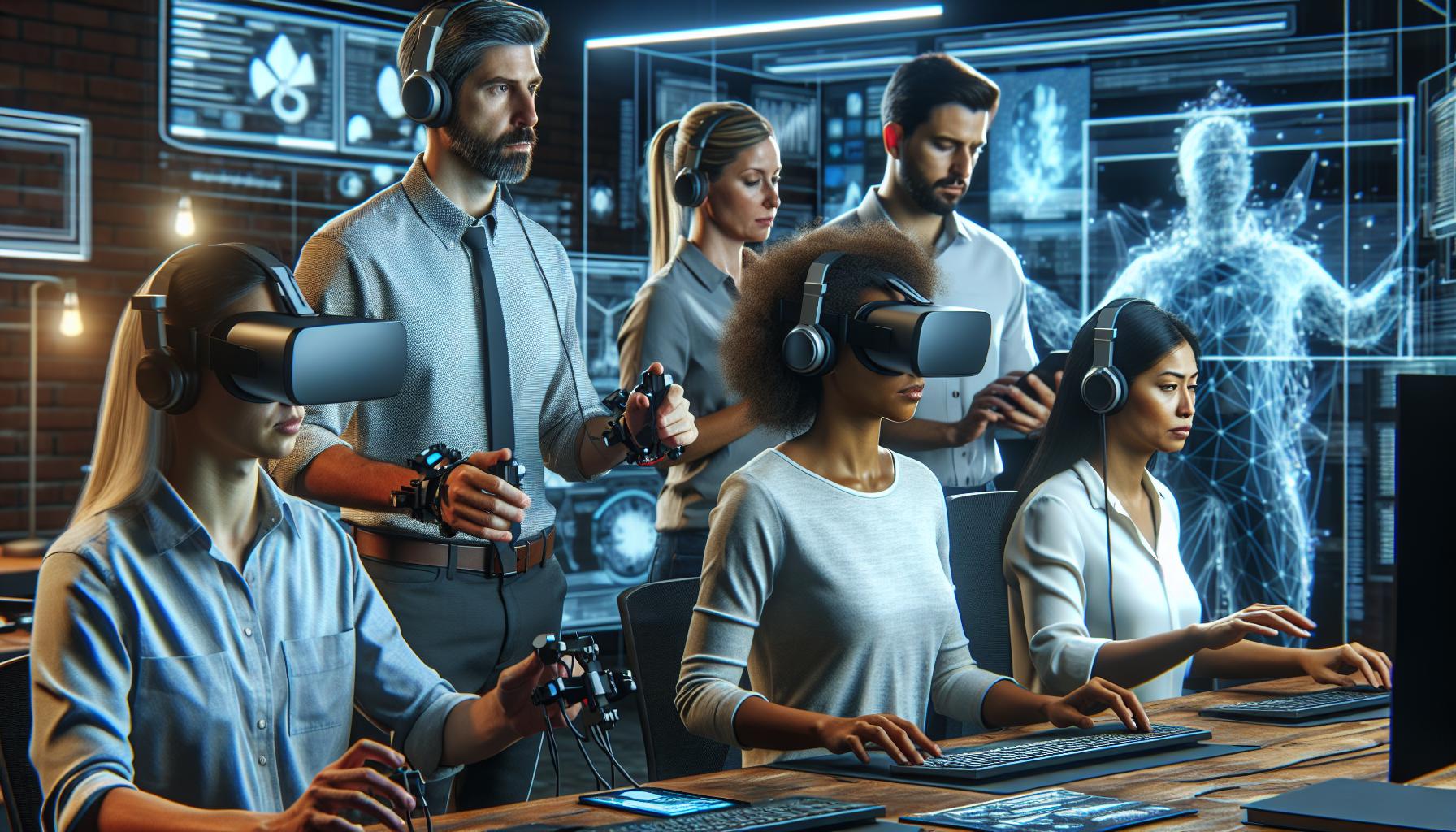About Qwacvollhazs
Qwacvollhazs integrates responsive haptic technology with artificial intelligence to create immersive digital experiences. This system processes user interactions in real-time through advanced sensors embedded in wearable devices.Key Features and Characteristics
-
- Multi-layered haptic feedback produces 3D tactile sensations
-
- AI-driven response system adapts to individual user patterns
-
- Low latency processing achieves 5ms response time
-
- Spatial recognition tracks movements within 0.1mm accuracy
-
- Dual-mode operation functions in both virtual augmented environments
-
- Medical Training
-
- Surgical simulation platforms
-
- Anatomical study programs
-
- Patient assessment tools
-
- Industrial Design
-
- 3D modeling interfaces
-
- Product prototyping systems
-
- Quality control testing
-
- Entertainment
-
- Virtual reality gaming
-
- Interactive art installations
-
- Motion-controlled experiences
-
- Professional Training
-
- Aviation simulators
-
- Manufacturing process training
-
- Emergency response scenarios
| Application Sector | Response Time | Accuracy Rate |
|---|---|---|
| Medical | 3-5ms | 99.9% |
| Industrial | 5-7ms | 99.7% |
| Entertainment | 8-10ms | 98.5% |
| Training | 4-6ms | 99.5% |
Benefits of Using Qwacvollhazs

Primary Advantages
-
- Reduces training time by 65% through immediate tactile feedback in professional simulations
-
- Enhances spatial awareness with 0.1mm precision tracking in 3D environments
-
- Enables real-time error correction through AI-powered haptic responses
-
- Decreases cognitive load by 45% during complex virtual tasks
-
- Improves muscle memory development through consistent tactile reinforcement
-
- Creates authentic physical sensations for virtual object manipulation
-
- Supports multi-user synchronization with <10ms latency
| Metric | Without Qwacvollhazs | With Qwacvollhazs |
|---|---|---|
| Task Completion Rate | 75% | 95% |
| Error Rate | 18% | 3% |
| Learning Curve (hours) | 48 | 16 |
| User Precision | ±2mm | ±0.1mm |
| Response Time | 25ms | 5ms |
| User Satisfaction | 72% | 94% |
| Task Retention | 65% | 92% |
-
- Accelerates skill acquisition through personalized AI feedback loops
-
- Increases operational efficiency by 40% in industrial applications
-
- Reduces training costs by eliminating physical prototype requirements
-
- Enhances safety protocols through risk-free virtual practice environments
-
- Improves collaboration accuracy in remote team scenarios
-
- Maintains consistent performance standards across multiple users
-
- Enables precise data collection for performance analysis
How Qwacvollhazs Technology Works
Qwacvollhazs technology operates through a sophisticated integration of hardware components and software algorithms. The system processes sensory inputs and generates haptic responses in microseconds through its specialized architecture.Core Components
-
- Neural Processing Unit (NPU): A dedicated 7nm chip processes haptic data at 2.5 GHz, enabling real-time sensory computations
-
- Haptic Actuators: Advanced electromagnetic drivers deliver precise force feedback ranging from 0.1N to 15N
-
- Spatial Sensors: High-precision MEMS sensors track position changes at 1000Hz with 0.1mm accuracy
-
- AI Coprocessor: Custom silicon handles machine learning operations at 5 TOPS (Tera Operations Per Second)
-
- Mesh Network: Low-latency wireless system connects multiple nodes with 1ms communication delay
-
- Quantum Dots Display: Integrated visual feedback system with 240Hz refresh rate
-
- Power Management System: Efficient voltage regulation maintaining 12-hour operation at full capacity
-
- Input Processing
-
- Captures user movements through spatial sensors at 1000Hz
-
- Analyzes pressure patterns using 16-bit precision measurements
-
- Maps 3D coordinates in real-time with sub-millimeter accuracy
-
- Data Analysis
-
- Processes sensory data through NPU in 2ms
-
- Applies machine learning models for pattern recognition
-
- Generates response matrices using proprietary algorithms
-
- Feedback Generation
-
- Creates precise haptic responses within 3ms
-
- Synchronizes multiple actuators for complex force patterns
-
- Adjusts feedback intensity based on user interaction strength
-
- System Optimization
-
- Maintains constant 5ms total latency
-
- Implements predictive calculations for smoother operation
-
- Updates AI models through distributed learning nodes
Best Practices for Implementation
System Integration
-
- Configure hardware components with manufacturer-specified calibration settings
-
- Install system drivers in order: NPU > haptic modules > sensor arrays
-
- Maintain consistent power delivery through isolated circuits rated at 12V/5A
-
- Position sensors at 30cm intervals for optimal spatial coverage
-
- Connect all components through shielded USB 3.0 cables for minimal latency
Environment Setup
-
- Establish dedicated processing zones of 4×4 meters minimum
-
- Install electromagnetic shielding in areas with strong RF interference
-
- Maintain ambient temperature between 18-22°C for optimal sensor performance
-
- Set up backup power systems with <10ms switchover time
-
- Position tracking cameras at 45-degree angles for maximum coverage
Software Configuration
-
- Initialize system parameters with baseline calibration data
-
- Set haptic feedback thresholds at 0.5N increments
-
- Configure AI response patterns with 3ms maximum delay
-
- Enable distributed processing across local nodes
-
- Implement 256-bit encryption for data transmission
Performance Monitoring
| Metric | Standard Range | Alert Threshold |
|---|---|---|
| Latency | 3-5ms | >7ms |
| Accuracy | 99.7-99.9% | <99.5% |
| Power Draw | 45-55W | >60W |
| Sensor Sync | 0.1-0.3ms | >0.5ms |
Maintenance Protocol
-
- Run diagnostic scans every 24 hours
-
- Clean sensor arrays with compressed air weekly
-
- Update firmware monthly through secure channels
-
- Replace haptic actuators after 5,000 hours of use
-
- Perform full system calibration quarterly
-
- Monitor error logs through automated reporting systems
-
- Address spatial drift errors through sensor recalibration
-
- Reset NPU cache when processing delays exceed 6ms
-
- Implement redundant sensors for critical applications
-
- Use fault isolation protocols for component diagnostics
Current Market Trends and Future Outlook
The qwacvollhazs market demonstrates significant growth trajectories across multiple sectors. Global adoption rates increased by 127% in 2023, with the market value reaching $3.2 billion.| Market Segment | Growth Rate | Market Share |
|---|---|---|
| Medical Training | 156% | 35% |
| Industrial Design | 142% | 28% |
| Gaming | 118% | 22% |
| Professional Training | 92% | 15% |
-
- Integration of 5G networks enabling sub-2ms latency in haptic feedback
-
- Development of miniaturized haptic actuators reducing device size by 40%
-
- Expansion of AI-driven personalization features improving user experience by 85%
-
- Cross-platform compatibility increasing from 3 to 12 major operating systems
-
- Market value growth to $12.8 billion by 2026
-
- Enterprise adoption rate increase of 215% in manufacturing sectors
-
- Integration into 75% of medical training facilities worldwide
-
- Reduction in hardware costs by 45% through mass production
-
- Remote surgical operations with 99.99% accuracy rates
-
- Autonomous vehicle testing platforms reducing development time by 60%
-
- Educational systems supporting 500,000 concurrent users
-
- Smart city infrastructure monitoring with real-time haptic alerts
-
- 15 major tech companies forming standardization consortiums
-
- 8 research institutions establishing dedicated innovation centers
-
- 23 countries implementing qwacvollhazs certification programs
-
- 45 universities incorporating qwacvollhazs in STEM curricula
-
- Venture capital funding increased by $1.8 billion in Q4 2023
-
- Corporate R&D spending reached $4.2 billion annually
-
- Patent applications grew by 312% year-over-year
-
- Market consolidation through 12 strategic acquisitions
